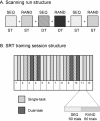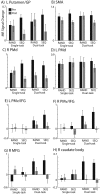The neural correlates of motor skill automaticity - PubMed (original) (raw)
The neural correlates of motor skill automaticity
Russell A Poldrack et al. J Neurosci. 2005.
Abstract
Acquisition of a new skill is generally associated with a decrease in the need for effortful control over performance, leading to the development of automaticity. Automaticity by definition has been achieved when performance of a primary task is minimally affected by other ongoing tasks. The neural basis of automaticity was examined by testing subjects in a serial reaction time (SRT) task under both single-task and dual-task conditions. The diminishing cost of dual-task performance was used as an index for automaticity. Subjects performed the SRT task during two functional magnetic imaging sessions separated by 3 h of behavioral training over multiple days. Behavioral data showed that, by the end of testing, subjects had automated performance of the SRT task. Before behavioral training, performance of the SRT task concurrently with the secondary task elicited activation in a wide network of frontal and striatal regions, as well as parietal lobe. After extensive behavioral training, dual-task performance showed comparatively less activity in bilateral ventral premotor regions, right middle frontal gyrus, and right caudate body; activity in other prefrontal and striatal regions decreased equally for single-task and dual-task conditions. These data suggest that lateral and dorsolateral prefrontal regions, and their corresponding striatal targets, subserve the executive processes involved in novice dual-task performance. The results also showed that supplementary motor area and putamen/globus pallidus regions showed training-related decreases for sequence conditions but not for random conditions, confirming the role of these regions in the representation of learned motor sequences.
Figures
Figure 1.
Schematic of the task design. A, Blocked design used during fMRI scanning. ST, Single task; DT, dual task; SEQ, sequence; RAND, pseudorandom. The ordering of single-/dual-task blocks was constant for all subjects, whereas the order of sequence and random blocks was counterbalanced across runs and subjects. B, Structure of the training sessions, showing alternation of sequence/pseudorandom blocks and placement of early/late dual-task probe blocks.
Figure 2.
Response time data from fMRI scans, with SE bars. ST, Single task; DT, dual task; Seq, sequence; Rand, pseudorandom.
Figure 3.
Response time data from training, separated by single-/dual-task and sequence/random conditions. ST, Single task; DT, dual task; seq, sequence; rand, pseudorandom.
Figure 4.
Thresholded statistical map for comparison of single-task condition (averaged over sequence and random blocks) versus rest (p < 0.05, cluster corrected for multiple comparisons). The top row presents results from pretraining session, and the bottom row presents posttraining results.
Figure 5.
Thresholded statistical map for comparison of single-task versus dual-task conditions (averaged over sequence and random conditions) (p < 0.05, cluster corrected for multiple comparisons). The top row presents results from pretraining session, and the bottom row presents posttraining results.
Figure 6.
Thresholded statistical map for interaction between pretraining/posttraining and single/dual task (p < 0.05, cluster corrected for multiple comparisons).
Figure 7.
Bar graphs of signal extracted from regions of interest, with SE. Statistical analyses of these data and stereotactic locations for each region are presented in Table 3. L, Left; R, right; MFG, middle frontal gyrus; SEQ, sequence; RAND, pseudorandom.
Similar articles
- Dual-task interference during initial learning of a new motor task results from competition for the same brain areas.
Rémy F, Wenderoth N, Lipkens K, Swinnen SP. Rémy F, et al. Neuropsychologia. 2010 Jul;48(9):2517-27. doi: 10.1016/j.neuropsychologia.2010.04.026. Epub 2010 Apr 29. Neuropsychologia. 2010. PMID: 20434467 - Changes in brain activation during the acquisition of a new bimanual coodination task.
Debaere F, Wenderoth N, Sunaert S, Van Hecke P, Swinnen SP. Debaere F, et al. Neuropsychologia. 2004;42(7):855-67. doi: 10.1016/j.neuropsychologia.2003.12.010. Neuropsychologia. 2004. PMID: 14998701 - Similar network activated by young and old adults during the acquisition of a motor sequence.
Daselaar SM, Rombouts SA, Veltman DJ, Raaijmakers JG, Jonker C. Daselaar SM, et al. Neurobiol Aging. 2003 Nov;24(7):1013-9. doi: 10.1016/s0197-4580(03)00030-7. Neurobiol Aging. 2003. PMID: 12928061 Clinical Trial. - Motor skill acquisition across short and long time scales: a meta-analysis of neuroimaging data.
Lohse KR, Wadden K, Boyd LA, Hodges NJ. Lohse KR, et al. Neuropsychologia. 2014 Jul;59:130-41. doi: 10.1016/j.neuropsychologia.2014.05.001. Epub 2014 May 14. Neuropsychologia. 2014. PMID: 24831923 Review. - Motor learning in man: a review of functional and clinical studies.
Halsband U, Lange RK. Halsband U, et al. J Physiol Paris. 2006 Jun;99(4-6):414-24. doi: 10.1016/j.jphysparis.2006.03.007. Epub 2006 May 26. J Physiol Paris. 2006. PMID: 16730432 Review.
Cited by
- Reinforcement learning in young adults with developmental language impairment.
Lee JC, Tomblin JB. Lee JC, et al. Brain Lang. 2012 Dec;123(3):154-63. doi: 10.1016/j.bandl.2012.07.009. Epub 2012 Aug 24. Brain Lang. 2012. PMID: 22921956 Free PMC article. - Systematic review of parameters of stimulation, clinical trial design characteristics, and motor outcomes in non-invasive brain stimulation in stroke.
Adeyemo BO, Simis M, Macea DD, Fregni F. Adeyemo BO, et al. Front Psychiatry. 2012 Nov 12;3:88. doi: 10.3389/fpsyt.2012.00088. eCollection 2012. Front Psychiatry. 2012. PMID: 23162477 Free PMC article. - A novel free-operant framework enables experimental habit induction in humans.
Gera R, Barak S, Schonberg T. Gera R, et al. Behav Res Methods. 2024 Apr;56(4):3937-3958. doi: 10.3758/s13428-023-02263-6. Epub 2023 Nov 21. Behav Res Methods. 2024. PMID: 37989835 Free PMC article. - Error-related brain state analysis using electroencephalography in conjunction with functional near-infrared spectroscopy during a complex surgical motor task.
Walia P, Fu Y, Norfleet J, Schwaitzberg SD, Intes X, De S, Cavuoto L, Dutta A. Walia P, et al. Brain Inform. 2022 Dec 9;9(1):29. doi: 10.1186/s40708-022-00179-z. Brain Inform. 2022. PMID: 36484977 Free PMC article. - Dissociable brain systems mediate vicarious learning of stimulus-response and action-outcome contingencies.
Liljeholm M, Molloy CJ, O'Doherty JP. Liljeholm M, et al. J Neurosci. 2012 Jul 18;32(29):9878-86. doi: 10.1523/JNEUROSCI.0548-12.2012. J Neurosci. 2012. PMID: 22815503 Free PMC article.
References
- Aron AR, Robbins TW, Poldrack RA (2004) Inhibition and the right inferior frontal cortex. Trends Cogn Sci 8: 170-177. - PubMed
- Asaad WF, Rainer G, Miller EK (1998) Neural activity in the primate prefrontal cortex during associative learning. Neuron 21: 1399-1407. - PubMed
- Bunge SA, Kahn I, Wallis JD, Miller EK, Wagner AD (2003) Neural circuits subserving the retrieval and maintenance of abstract rules. J Neurophysiol 90: 3419-3428. - PubMed
- Corbetta M, Shulman GL (2002) Control of goal-directed and stimulus-driven attention in the brain. Nat Rev Neurosci 3: 201-215. - PubMed
- Curran T, Keele SW (1993) Attentional and nonattentional forms of sequence learning. J Exp Psychol Learn Mem Cogn 19: 189-202.
Publication types
MeSH terms
Grants and funding
- RR13642/RR/NCRR NIH HHS/United States
- RR12169/RR/NCRR NIH HHS/United States
- RR08655/RR/NCRR NIH HHS/United States
- P41 RR013642/RR/NCRR NIH HHS/United States
- C06 RR012169/RR/NCRR NIH HHS/United States
LinkOut - more resources
Full Text Sources






